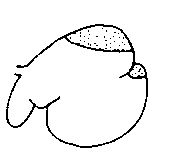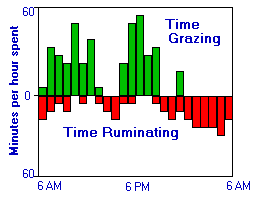VIVO Pathophysiology
Rumen Physiology and Rumination
The rumen is a fermentation vat par excellance, providing an anaerobic environment, constant temperature and pH, and good mixing. Well-masticated substrates are delivered through the esophagus on a regular schedule, and fermentation products are either absorbed in the rumen itself or flow out for further digestion and absorption downstream.
Ruminants evolved to consume and subsist on roughage - grasses and shrubs built predominantly of cellulose. Despite the fact that some ruminants, feedlot steers for example, are feed large quantities of grain, this section will focus on a ruminant's "natural diet".
Dynamics of Cranial Digestion
Feed, water and saliva are delivered to the reticulorumen through the esophageal orifice. Heavy objects (grain, rocks, nails) fall into the reticulum, while lighter material (grass, hay) enters the rumen proper. Added to this mixture are voluminous quantities of gas produced during fermentation.
Ruminants produce prodigious quantities of saliva. Published estimates for adult cows are in the range of 100 to 150 liters of saliva per day! Aside from its normal lubricating qualities, saliva serves at least two very important functions in the ruminant:
- provision of fluid for the fermentation vat
- alkaline buffering - saliva is rich in bicarbonate, which buffers the large quanitity of acid produced in the rumen and is probably critical for maintainance of rumen pH.
All these materials within the rumen partition into three primary zones based on their specific gravity. Gas rises to fill the upper regions, grain and fluid-saturated roughage ("yesterday's hay") sink to the bottom, and newly arrived roughage floats in a middle layer.

The rate of flow of solid material through the rumen is quite slow and dependent on its size and density. Water flows through the rumen rapidly and appears to be critical in flushing particulate matter downstream.
As fermentation proceeds, feedstuffs are reduced to smaller and smaller sizes and microbes constantly proliferate. Ruminal contractions constantly flush lighter solids back into the rumen. The smaller and more dense material tends to be pushed into the reticulum and cranial sac of the rumen, from which it is ejected with microbe-laden liquid through the reticulo-omasal orifice into the omasum.
The function of the omasum is rather poorly understood. It may function to absorb residual volatile fatty acids and bicarbonate. The tendency is for fluid to pass rapidly through the omasal canal, but for particulate matter to be retained between omasal leaves. Periodic contractions of the omasum knocks flakes of material out of the leaves for passage into the abomasum.
The abomasum is a true, glandular stomach which secretes acid and otherwise functions very similarly to the stomach of a monogastric. One fascinating specialization of this organ relates to its need to process large masses of bacteria. In contrast to the stomach of non-ruminants, the abomasum secretes lysozyme, an enzyme that efficiently breaks down bacterial cell walls.
The processes described above apply to adult ruminants. For the first month or so of life, the ruminant is functionally a monogastric. The forestomachs are formed, but are not yet fully developed. If milk is introduced into such a rumen, it basically rots rather than being fermented. To avoid this problem in such young ruminants, suckling causes a reflex closure of muscular folds that form a channel from the esophageal orifice toward the omasum (the esophageal groove), shunting milk away from the rumen and straight toward the stomach where it can be curdled by rennin and eventually digested enzymatically.
Reticuloruminal Motility
An orderly pattern of ruminal motility is initiated early in life and, except for temporary periods of disruption, persists for the lifetime of the animal. These movements serve to mix the ingesta, aid in eructation of gas, and propel fluid and fermented foodstuffs into the omasum. If motility is suppressed for a significant length of time, ruminal impaction may result.
A cycle of contractions occurs 1 to 3 times per minute. The highest frequency is seen during feeding, and the lowest when the animal is resting. Two types of contractions are identified:
- Primary contractions originate in the reticulum and pass caudally around the rumen. This process involves a wave of contraction followed by a wave of relaxation, so as parts of the rumen are contracting, other sacs are dilating.
- Secondary contractions occur in only parts of the rumen and are usually associated with eructation.
The animation below is based on data collected by radiographing sheep (Wyburn, 1980) and should impart at least some appreciation of the complexity of ruminal motility. Although shown much faster than in life, the major reticuloruminal contractions are timed appropriately. Note the movements which bring the gas bubble (stippled area) forward to the esophagus for eructation.

What about control of rumen motility? The forestomachs possess a rich enteric nervous system, but coordinated contractions require central input. Motility centers in the brainstem control both the rate and strength of contraction via vagal efferents. Cutting the vagus nerve in a ruminate abolishes coordinated reticuloruminal motility. There are also vagal afferents from the rumen to the motility centers which allow stretch receptors and chemoreceptors in the rumen to modulate contractility.
Conditions inside the rumen can significantly affect motility. If, for example, ruminal contents become very acidic (as occurs in grain engorgement), motility will essentially cease. Also, the type of diet influences motility: animals on a high roughage diet have a higher frequency of contractions than those on a diet rich in concentrates.
Rumination and Eructation
Ruminants are well known for "cud chewing". Rumination is regurgitation of ingesta from the reticulum, followed by remastication and reswallowing. It provides for effective mechanical breakdown of roughage and thereby increases substrate surface area to fermentative microbes.
Regurgitation is initiated with a reticular contraction distinct from the primary contraction. This contraction, in conjunction with relaxation of the distal esophageal sphincter, allows a bolus of ingesta to enter the esophagus. The bolus is carried into the mouth by reverse peristalsis. The fluid in the bolus is squeezed out with the tongue and reswallowed, and the bolus itself is remasticated, then reswallowed.
 Rumination occurs predominantly when the animal is resting and not eating, but that is a considerable fraction of the animal's lifespan. The chart shown here (adapted from Lofgreen et al., J Animal Sci 16:773, 1957) depicts how steers spend their day on an alfalfa pasture relative to time spent grazing and ruminating.
Rumination occurs predominantly when the animal is resting and not eating, but that is a considerable fraction of the animal's lifespan. The chart shown here (adapted from Lofgreen et al., J Animal Sci 16:773, 1957) depicts how steers spend their day on an alfalfa pasture relative to time spent grazing and ruminating.
Fermentation in the rumen generates enormous, even frightening, quantities of gas. We're talking about 30-50 liters per hour in adult cattle and about 5 liters per hour in a sheep or goat. Eructation or belching is how ruminants continually get rid of fermentation gases. As mentioned above, an eructation is associated with almost every secondary ruminal contraction. Eructated gas travels up the esophagus at 160 to 225 cm per second (Stevens and Sellers, Am J Physiol 199:598, 1960) and, interestingly, a majority is actually first inspired into the lungs, then expired.
Anything that interferes with eructation is lifethreatening to the ruminant because the expanding rumen rapidly interferes with breathing. Animals suffering ruminal tympany (bloat) die from asphyxiation.
Rumen gases, particularly methane, are increasingly in the news because of their contribution to greenhouse gas and climate change. As with most topics that attract the attention of activists and politicians, it is somewhat difficult to obtain accurate estimates of the contribution of ruminant digestive processes to global greenhouse gas. However, data from the Food and Agriculture Organization of the United Nations indicates that ruminants are responsible for roughly 20% of global methane emmisions, which equates to approximately 3-5% of total greenhouse gas production.
Send comments to Richard.Bowen@colostate.edu

